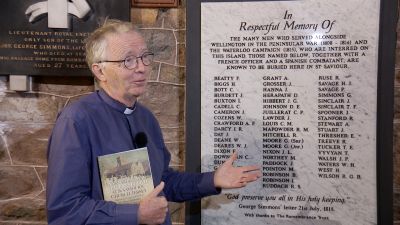St Saviour's Church breathes fresh life into the stories of over 100 Napoleonic war veterans

A two year project at St Saviour's Church in Jersey, has led to the discovery of the graves of over 100 war veterans from the Napoleonic Wars. It first ignited the attention of Rector Peter Dyson in 2018 when he received a letter asking about just one grave.
Revd Dyson then went to a dinner party where he was told by another person: "I think there are several Waterloo persons in your churchyard."
"Several" turned out to be an understatement. It is now thought to contain more soldiers than any other churchyard in the British Isles. On making the initial discovery, the Waterloo Committee was formed to organise the tribute to the forgotten heroes they went on to discover. A plaque has been erected in the Church naming the 58 soldiers who fought with Wellington in the Peninsular War (1808-1814) and the Battle of Waterloo (1815). It further details an appendix of an additional 43 soldiers who fought in the Napoleonic Wars in other theatres. But how did they end up in Jersey?
Some of them went on to marry into Jersey families and became ensconced in local society. St Saviour, at the time, also happened to be the apex of religious and social life in the island, which explains why so many veterans were buried there. The Lieutenant-Governor had relocated to St Saviour from St Helier in 1822, and it was the base for the island's Dean. A commemorative book, written by Sir William Mahon, an expert on Wellington's Battles, and a committee of local historians. has been published alongside the project and breathes life into the names rediscovered. One story is that of Daniel Herapath who joined the army at the age of 12 as a drummer boy.
Daniel Herapath is one of four or five soldiers whose graves could not be identified. Being poor their graves were not afforded a memorial, which meant they are thought to have been buried in a paupers grave, in a separate area of the churchyard. "One of the sadnesses", said Revd. Dyson, "is that most of these (names) are officers. Because the officers were wealthy and their regiments kept records, those who were the foot soldiers and the privates, it's far harder to find them." All the graves identified have been marked and will have an English rose planted on them, to mark each of the veterans buried. The soldiers believed to be resting in the "paupers" section of the graveyard, will share one between them, to ensure none of them are forgotten again. "I love the fact that their names have been lost...and they're back to life, and going back to Daniel Herapath, he went through so much, and I'm so pleased, he's remembered."
Islanders are encouraged to take a walk through the churchyard and visit the church, where the plaque is in situ.
WATCH: Iselin Jones' report...